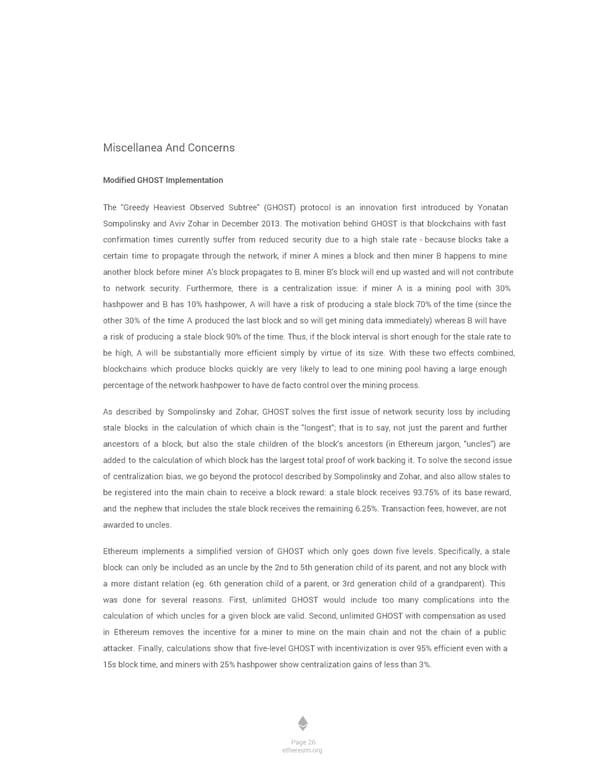Miscellanea And Concerns Modified GHOST Implementation The "Greedy Heaviest Observed Subtree" (GHOST) protocol is an innovation first introduced by Yonatan Sompolinsky and Aviv Zohar in December 2013. The motivation behind GHOST is that blockchains with fast confirmation times currently suffer from reduced security due to a high stale rate - because blocks take a certain time to propagate through the network, if miner A mines a block and then miner B happens to mine another block before miner A's block propagates to B, miner B's block will end up wasted and will not contribute to network security. Furthermore, there is a centralization issue: if miner A is a mining pool with 30% hashpower and B has 10% hashpower, A will have a risk of producing a stale block 70% of the time (since the other 30% of the time A produced the last block and so will get mining data immediately) whereas B will have a risk of producing a stale block 90% of the time. Thus, if the block interval is short enough for the stale rate to be high, A will be substantially more efficient simply by virtue of its size. With these two effects combined, blockchains which produce blocks quickly are very likely to lead to one mining pool having a large enough percentage of the network hashpower to have de facto control over the mining process. As described by Sompolinsky and Zohar, GHOST solves the first issue of network security loss by including stale blocks in the calculation of which chain is the "longest"; that is to say, not just the parent and further ancestors of a block, but also the stale children of the block's ancestors (in Ethereum jargon, "uncles") are added to the calculation of which block has the largest total proof of work backing it. To solve the second issue of centralization bias, we go beyond the protocol described by Sompolinsky and Zohar, and also allow stales to be registered into the main chain to receive a block reward: a stale block receives 93.75% of its base reward, and the nephew that includes the stale block receives the remaining 6.25%. Transaction fees, however, are not awarded to uncles. Ethereum implements a simplified version of GHOST which only goes down five levels. Specifically, a stale block can only be included as an uncle by the 2nd to 5th generation child of its parent, and not any block with a more distant relation (eg. 6th generation child of a parent, or 3rd generation child of a grandparent). This was done for several reasons. First, unlimited GHOST would include too many complications into the calculation of which uncles for a given block are valid. Second, unlimited GHOST with compensation as used in Ethereum removes the incentive for a miner to mine on the main chain and not the chain of a public attacker. Finally, calculations show that five-level GHOST with incentivization is over 95% efficient even with a 15s block time, and miners with 25% hashpower show centralization gains of less than 3%. Page 26 ethereum.org
 Ethereum White Paper by Vitalik Buterin Page 29 Page 31
Ethereum White Paper by Vitalik Buterin Page 29 Page 31